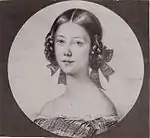Princess Anna of Prussia
Princess Maria Anna Friederike (17 May 1836 – 12 June 1918) was a Princess of Prussia. She was usually called Anna.
| Princess Anna | |||||
|---|---|---|---|---|---|
| Landgravine of Hesse | |||||
 | |||||
| Born | 17 May 1836 Berlin | ||||
| Died | 12 June 1918 (aged 82) Frankfurt | ||||
| Spouse | |||||
| Issue | Frederick William III, Landgrave of Hesse Elisabeth, Hereditary Princess of Anhalt Alexander Frederick, Landgrave of Hesse Frederick Charles, Landgrave of Hesse Princess Marie-Polyxene Princess Sybille Marguerite | ||||
| |||||
| House | Hohenzollern | ||||
| Father | Prince Charles of Prussia | ||||
| Mother | Princess Marie of Saxe-Weimar-Eisenach | ||||
| Prussian Royalty |
| House of Hohenzollern |
|---|
 |
| Descendants of Frederick William III |
Early life

Anna was the youngest of the three children of Prince Charles of Prussia and Princess Marie of Saxe-Weimar-Eisenach.
As a beautiful young princess, she was the object of much attention at court. In the winter of 1852, the young Emperor Franz Joseph I of Austria met her in Berlin, fell in love, and wished to propose to her. His mother, Archduchess Sophie of Austria, wrote to her sister Queen Elisabeth of Prussia referring to "the happiness that showed itself to him like a fleeting dream and made an impression on his heart -- alas -- much stronger and deeper than I had first thought."[1] However, Anna was already engaged at that time, and as an added complication, there were strong feelings against an alliance with Austria among Prussian statesmen. Franz Joseph's mother asked, "whether there is any hope that this sad marriage, which they are imposing on this charming Anna and which leaves her no prospect of happiness whatsoever, could be prevented,"[1] but to no avail. Sophie predicted that Anna's marriage to her betrothed, Frederick William of Hesse-Kassel, would be unhappy, which turned out to be correct.
Marriage and issue
On 26 May 1853, Anna married her second cousin Prince Frederick William of Hesse-Kassel at Charlottenburg Palace in Berlin. Anna was the second wife of her new husband, who nine years previously had experienced the traumatic death in childbirth of his beloved first wife, Grand Duchess Alexandra Nikolaevna of Russia. He never got over this loss, which took place less than a year after his wedding to Alexandra. Like Sophie correctly predicted, Frederick's relationship with Anna was polite but emotionally distant. They did however have six children, being:
- Prince Frederick William III of Hesse (1854–1888); never married; died at sea on a voyage from Batavia to Singapore.
- Princess Elisabeth Alexandra Charlotte of Hesse (1861–1955); married Leopold, Hereditary Prince of Anhalt and had issue.
- Prince Alexander Frederick of Hesse (1863–1945); married Baroness Gisela Stockhorner von Starheim, daughter of Oto, Baron Stockhorner von Starheim and Emilie Susanne Hildegard, Baroness von Wolzogen-Neuhaus; had issue.
- Prince Frederick Charles of Hesse, King of Finland (1868–1940); married Princess Margaret of Prussia and had issue.
- Princess Marie-Polyxene of Hesse (1872–1882); died at age 10 of osteomyelitis.
- Princess Sybille Marguerite of Hesse (1877–1925); married Friedrich Alexander Henry Robert Carl Albert, Baron von Vincke (divorced 1923).
Assessments
Queen Victoria's daughter, Victoria, Princess Royal, who was married to Anna's cousin, the future Emperor of Germany, wrote about Anna:
- "...[she] is very pretty, the most splendid figure you ever saw, but I do not like her style quite, her gowns are a good deal fuller than the Empress' and so low, I cannot bear that; and I do not like to see the Princesses dancing about with everybody ...".[2]
However, Anna was also a highly intelligent woman who presided over a court salon of outstanding artists and musicians, including Johannes Brahms, Clara Schumann, Anton Rubinstein, and Julius Stockhausen. She herself was a classically trained pianist of great talent and ability who studied under Theodor Kullak.[3] Brahms dedicated his Piano Quintet to her in 1865.[4]
Unusually for a Hessian landgravine, she converted to Catholicism in 1901, which led to political complications.[5]
Anna was the subject of one of the most famous paintings by Franz Xaver Winterhalter, in which she is depicted wearing a sweeping dress of tulle over pink silk.
Death and burial
Anna died on 12 June 1918, in Frankfurt at the age of 82. She is buried in Fulda Cathedral before the altar to St. Anne. The Latin inscription is: Hic iacet Serenissima Landgrafia Hassiae ANNA Principissa Borussiae nata Berolini die 17. maii 1836 obiit Francofurti die 12. junii 1918 + Misericordias Domini in aeternum cantabo R.I.P. [translation: Here lies the most serene Landgravine of Hesse, ANNA, Princess of Prussia, born in Berlin on May 17, 1836, died in Frankfurt on June 12, 1918. I will sing the mercies of the Lord forever. R.I.P.]
Honours
Ancestry
References
| Wikimedia Commons has media related to Princess Anna of Prussia. |
- Hamann, Brigitte. Elisabeth. Kaiserin wider Willen. Munich, 1981, p. 8.
- Letter to Queen Victoria, 12 February 1858.
- http://www.retrobibliothek.de
- "Piano Quintet, Op.34 (Brahms, Johannes) - IMSLP: Free Sheet Music PDF Download".
- Röhl, John. Kaiser, Hof und Staat. Wilhelm II. und die deutsche Politik, Munich, 1988, p. 106.